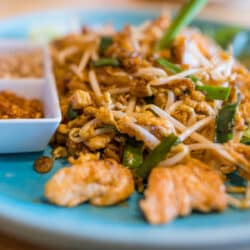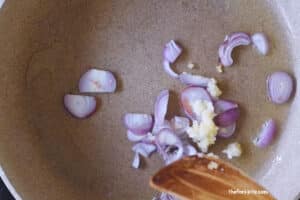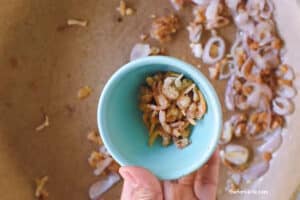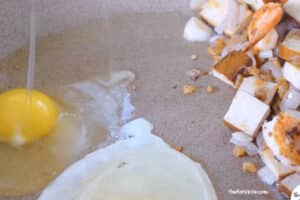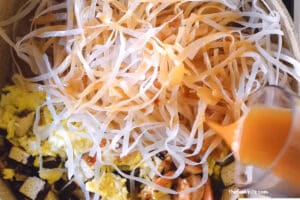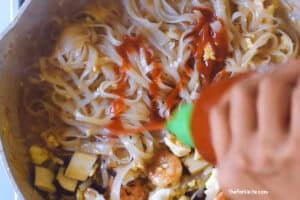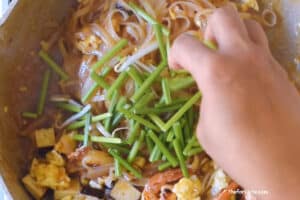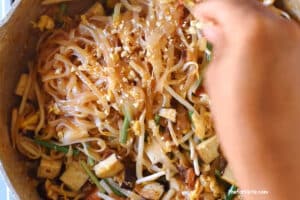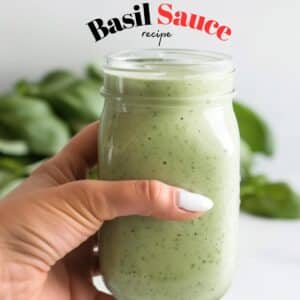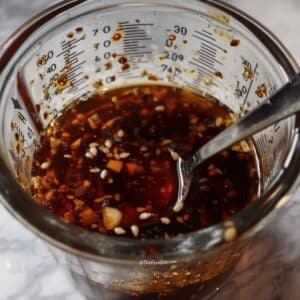"What does Pad Thai taste like?" As a fan of this iconic dish, I've often pondered over the symphony of flavors that make Pad Thai a delight to the senses. From sweet, savory, sour to that kick of spice - there's so much going on in this humble noodle dish. Get ready to join me on this flavor-packed journey as we delve into Thailand's heart (and taste) right on your plate!
Pad Thai offers a delightful medley of flavors. Each bite delivers a harmonious blend of sweet, sour, salty, and umami notes, attributed to the unique sauce made with tamarind, palm sugar, fish sauce, and soy sauce. Balanced with the mildness of rice noodles, the dish is also enhanced with various textures from tofu, bean sprouts, and crushed peanuts.
Take aways:
- Tangy Delight: Pad Thai's unique tanginess comes primarily from the sour taste of tamarind, a defining ingredient in Thai cuisine.
- Sweet Harmony: The sweetness in Pad Thai, a characteristic Thai flavor profile, originates from palm sugar, offering a perfect balance to tamarind's sourness.
- Savory Depth: The complexity of Pad Thai's taste is enriched by fish sauce and soy sauce, infusing a savory depth and salty umami essence into the dish.
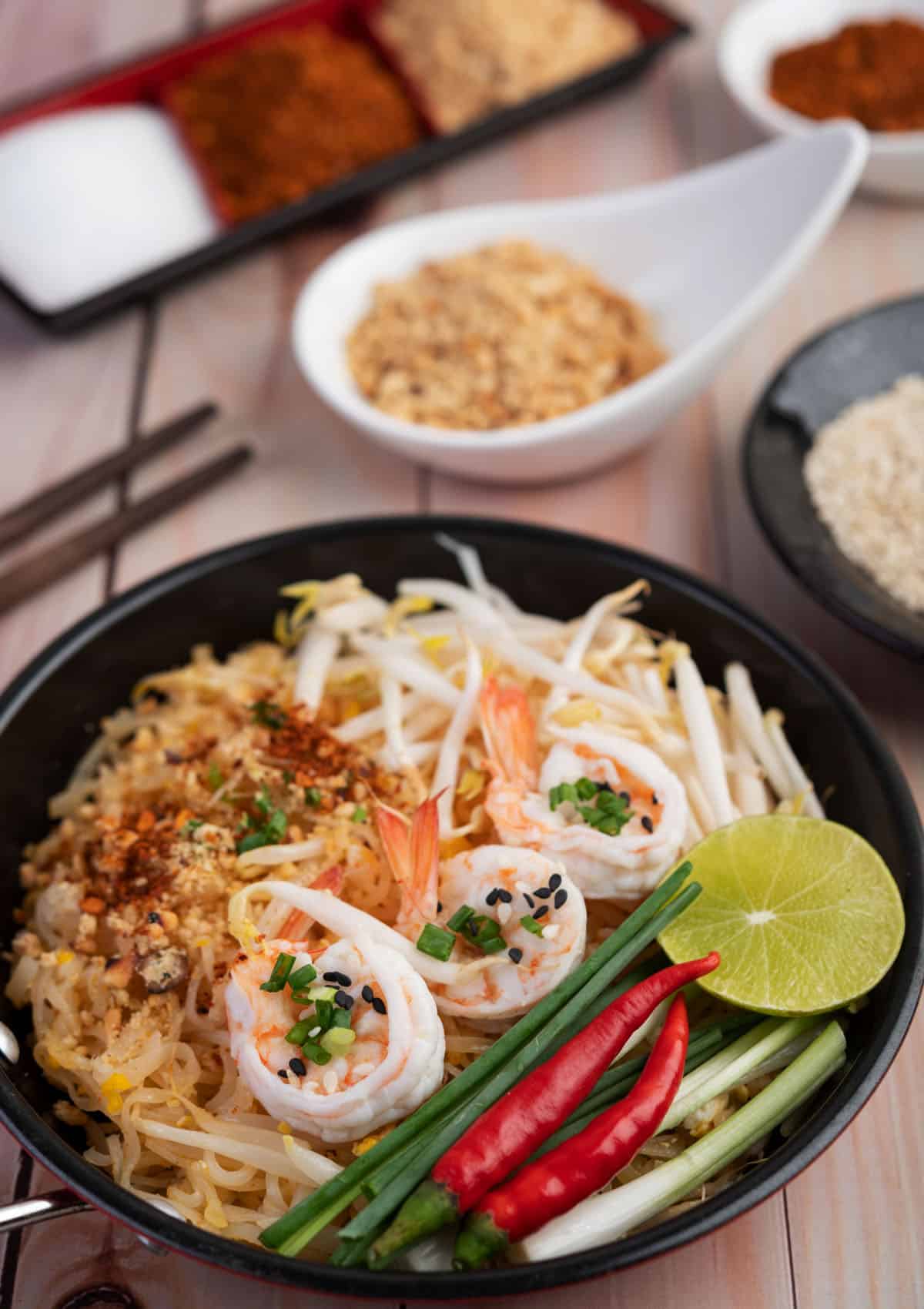
What exactly is Pad Thai?
In my previous post, I made a Pad Thai recipe, which is a traditional dish from Thailand. It's a stir-fried dish with rice noodles, eggs, vegetables, and proteins like tofu or chicken. It's tossed in a sweet and sour sauce, usually made from tamarind paste, fish sauce, garlic, and palm sugar.
The ingredients' textures combine to create a unique experience for your tastebuds. Toppings such as bean sprouts, crushed peanuts, and fresh lime juice add a unique crunchy element that makes the dish special.
What does Pad Thai taste like?
| Flavor Element | Description | Contribution to Pad Thai Taste |
|---|---|---|
| Tamarind | A sour fruit used in pulp form | Provides the signature tangy, sour note |
| Palm Sugar | A sweetener made from sap | Offers the characteristic sweetness, counterbalancing the sourness |
| Fish Sauce | Fermented fish and sea salt | Adds the savory, umami element |
| Soy Sauce | Fermented soybeans and wheat | Enhances the overall saltiness and depth of flavor |
| Rice Noodles | Mild, starchy staple | Serves as a neutral base, absorbing the sauce flavors |
| Tofu | Soybean curd | Adds softness and mild flavor, soaking up the sauce |
| Bean Sprouts | Sprouted mung beans | Provides a crunch, offering contrast to the soft noodles |
| Peanuts | Crushed or whole | Delivers a nutty flavor and an extra layer of crunch |
| Lime | Squeezed over top | Brightens the dish with its zesty acidity |
The balanced fusion of five key tastes
Now, onto the heart of Pad Thai - its flavor profile. Pad Thai's magic lies in its harmony of five key tastes that, when combined, make for a mouthwatering medley that leaves your taste buds craving more. Let's dissect this flavor harmony:
1 Sweet: The role of palm sugar
First, we have sweetness, delivered through palm sugar. Palm sugar lends a mellow sweetness that ties the ingredients together, smoothing out any sharp edges in flavor. It's the sweetness that doesn't steal the show but lets other flavors shine, all while quietly playing a crucial role.
2 Sour: Tamarind's tangy influence
Next, we add sourness, introduced via tamarind paste. Tamarind, a fruit known for its tartness, plays the perfect foil to the palm sugar's sweetness. It cuts through, balancing the sweetness, and brightens the overall flavor profile of the dish.VBB
3 Spicy: The heat of chili
Then comes the spice, brought to the party by dried red chilies. This kick of heat isn't just about making your eyes water but adding a depth of flavor that makes Pad Thai utterly addictive. But remember, we're looking for a balance, so the spice doesn't overpower but adds just the right level of excitement.
4 Salty: The depth of fish sauce
Fish sauce adds the much-needed salty touch to our Pad Thai. It's a condiment with a strong character, providing a depth and saltiness that no ordinary salt can. The fish sauce combines sweet, sour, and spicy notes, creating a complex and layered taste.
5 Umami: An underpinning sensation
Finally, the umami - the sensation that brings a satisfying, savory depth to the dish. Shrimp or tofu proteins provide a rich, meaty flavor known as umami, while fish sauce and tamarind intensify it. The underpinning sensation rounds off the Pad Thai experience, making it a dish to remember.
How to make Pad Thai at Home
As much as I hate to admit it, my recipe is almost as good as one we enjoy at a local restaurant. It's a great feeling when I can make something nearly as good as something from my favorite restaurant. Knowing how to recreate this delicious dish has made me a better cook, and I'm sure it will continue to do so.
Ingredients for success:
No Pad Thai would be complete without the sweet and sour flavors of palm sugar and tamarind paste. I learned these two were essential components when I figured out the best Pad Thai recipe. Palm sugar has a unique flavor that is not too sweet and lends an earthy sweetness, while tamarind paste adds a tart flavor to Pad Thai. As a bonus, I like to add my own secret ingredient - Sriracha sauce!
These secret ingredients can be tricky to find, making Pad Thai a dish that might not always be kitchen-friendly. But if you have access to a Ranch 99 market, Asian grocer, or the internet, you should be able to get your hands on these Pad Thai essentials and whip up the best Pad Thai dish.
Pad Thai is my favorite dish; I'm sure it will become yours too. Adding palm sugar, tamarind paste, and Sriracha to Pad Thai will give you a flavor. Give it a try - you won't regret it!
Read:
Making Pad Thai sauce ahead of time.
Making the sauce is easy; you can store it in the refrigerator for up to 30 days. You can save time by making the dish and help create a consistent flavor between batches. At the same time, it gives you flexibility - if you're short on time when cooking the Pad Thai, having the sauce ready saves precious moments.
If your prepared sauce solidifies a bit, don't worry - you can easily pop it in the microwave for 30 seconds or less, and it will be ready to use. Making the sauce ahead of time helps to ensure that your Pad Thai is always tasty and flavorful.
Ready to get started? This Pad Thai sauce is sure to become your go-to recipe! Click here for my favorite Pad Thai Sauce recipe.
Why make Pad Thai sauce ahead of time?
Preparing Pad Thai sauce in advance is a great way to save time when making a delicious meal. It allows you to quickly throw together all the ingredients for a tasty Pad Thai dish and have it ready to go in no time. Plus, you don't need to worry about measuring out all the ingredients for the sauce because it's already done.
Having pre-made Pad Thai sauce on hand also means that anytime you're in the mood for some Pad Thai, you can quickly whip up a meal without worrying about all the time-consuming steps of making a sauce from scratch.
Extra Tip:
When cooking Pad Thai, it's important to remember that you should only cook one or two servings at once to prevent overcrowding. This is because overcrowded pans create mushy noodles, which nobody wants! It might seem like a lot when you initially pour in the sauce, but keep tossing and stirring the noodles to ensure they soak up some of the sauce. The extra will reduce as you keep frying, leaving you with the perfect Pad Thai dish.
What are the ingredients?
Here are the ingredients that go into the dish so you can get a virtual taste and understand why it deserves a try.
- 8 ounces rice noodles (fresh or rehydrated)
- 3 tablespoon chives
- 8 shrimp (medium-sized)
- 3 cloves minced garlic
- 1 tablespoon shallots
- 1 tbsp sweet radish
- 1 tablespoon dried shrimp (optional)
- 2 eggs
- 4 oz tofu (firm)
- 4 oz beansprouts
- 1 or 1 ½ cups (Pad Thai sauce)
- 1 tablespoon crushed roasted peanuts
- 2 tablespoon cooking oil
Step-by-step instructions:
If using Pad Thai noodles in a box:
Fill a large pot with water and bring it to a rolling boil. Once boiling, add the Pad Thai noodles and stir them occasionally. Cook according to the package's directions. Drain the noodles, discard the liquid, and set them aside.
For the main dish:
Step 1 Heat the oil.
Using a large wok or skillet, heat the oil over medium heat. Oil helps evenly distribute the heat, ensuring that all ingredients are cooked correctly and that none stick to the pan's bottom.
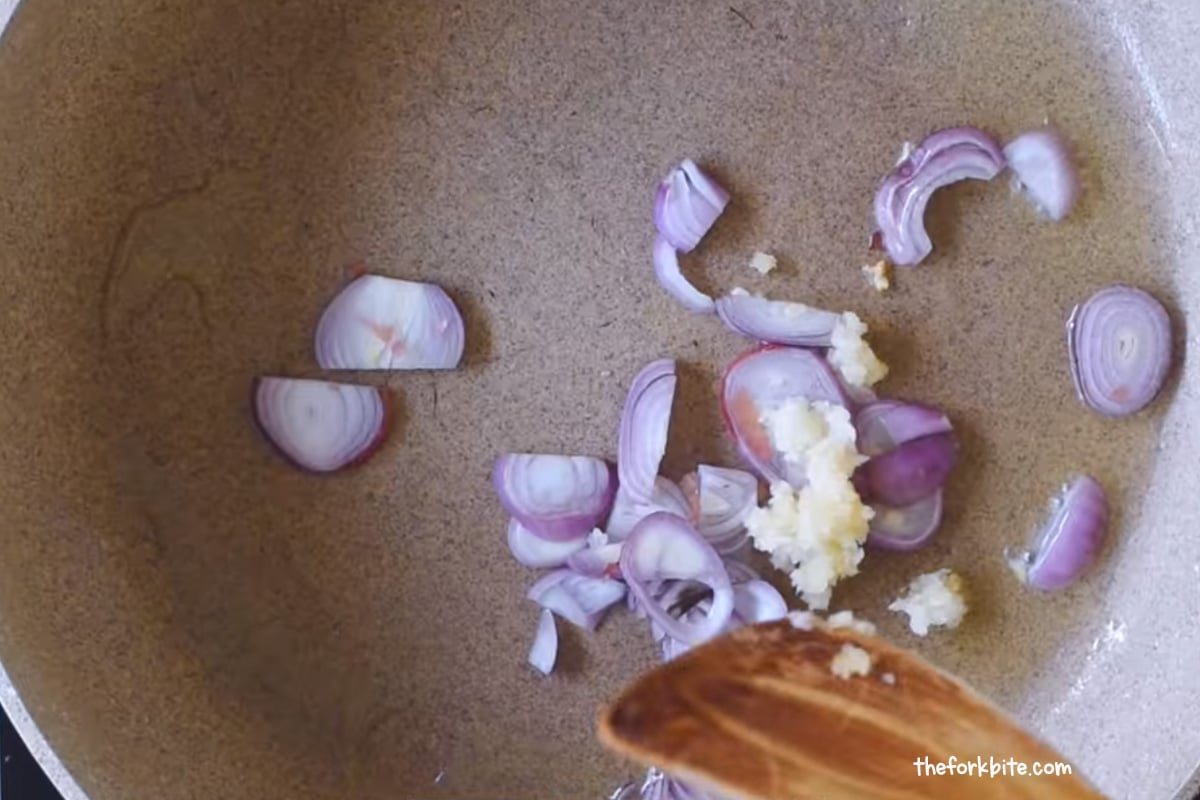
Step 2 Sauté aromatics.
Add the shallots and garlic, and sauté them for about 1 minute or until tender. Sauteing them briefly will help release all their flavors, creating a delicious base for your meal.
Step 3 Add the sweet radish, dried shrimp (optional), and firm tofu.
Add the sweet radish, dried shrimp (if using), and firm tofu. Cook these ingredients for about 1 minute or until they are heated and fragrant.
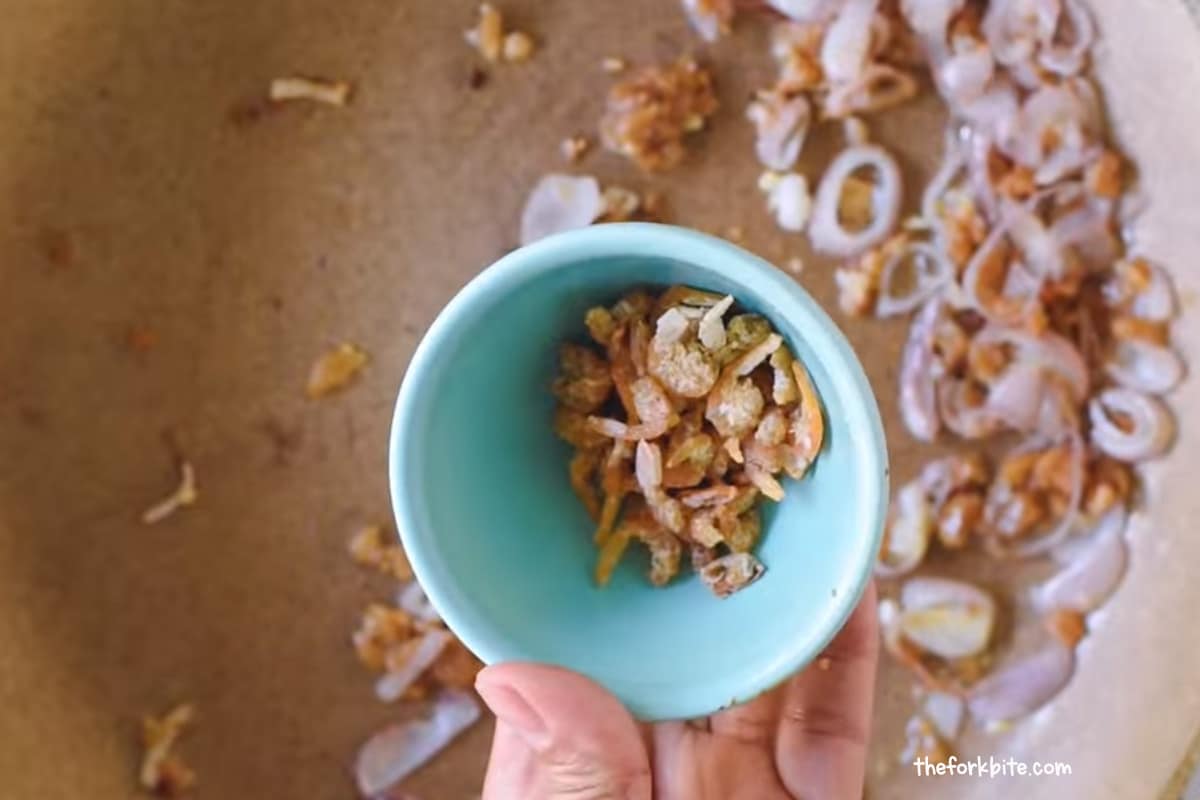
Step 4 Add cooked shrimp (or any protein).
Drop the cooked shrimp or any of your favorite proteins and stir for about 1 minute. Adding cooked proteins to the dish will add more flavors and texture, making it a tasty and satisfying meal.
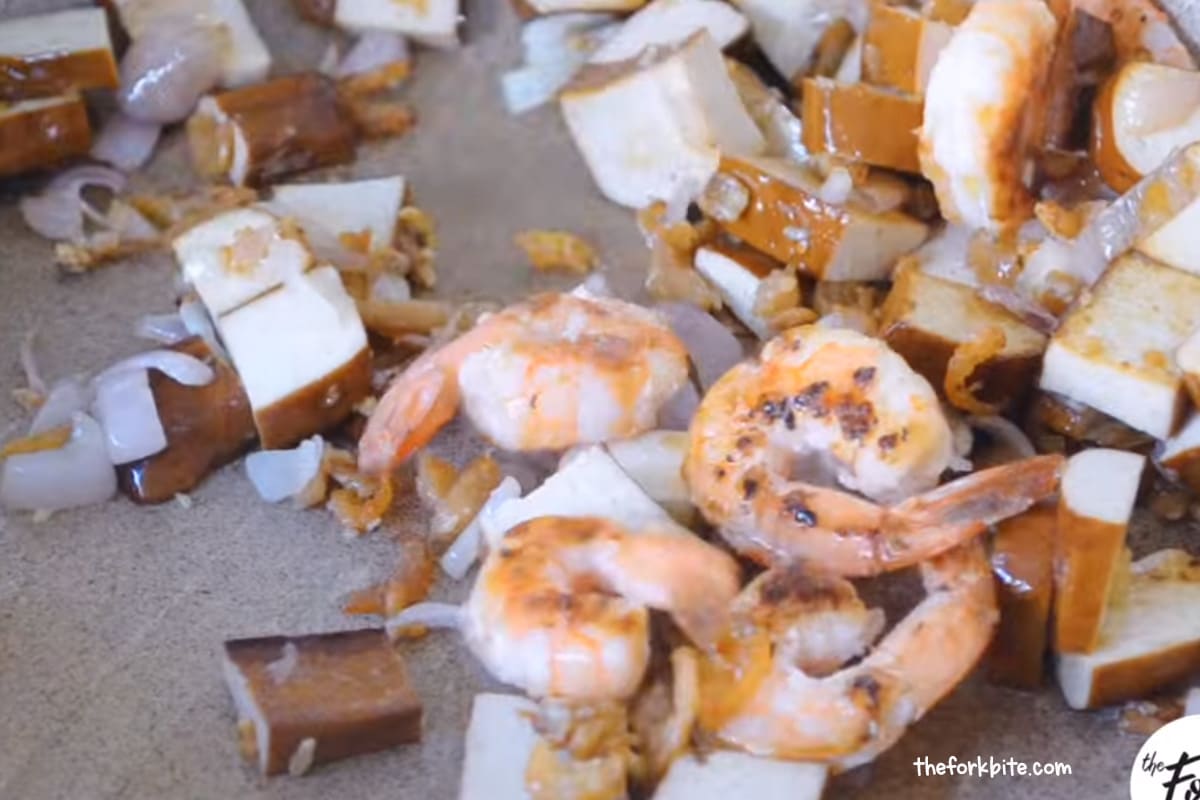
Step 5 Push ingredients to one side of the wok/skillet.
Push all ingredients to one side of the wok/skillet, creating a clear space in the middle. Crack two eggs into the skillet and cook over medium heat until they are slightly firm but moist. They lightly scramble by moving the eggs around the skillet as they cook. Move them aside once cooked. Move them aside.
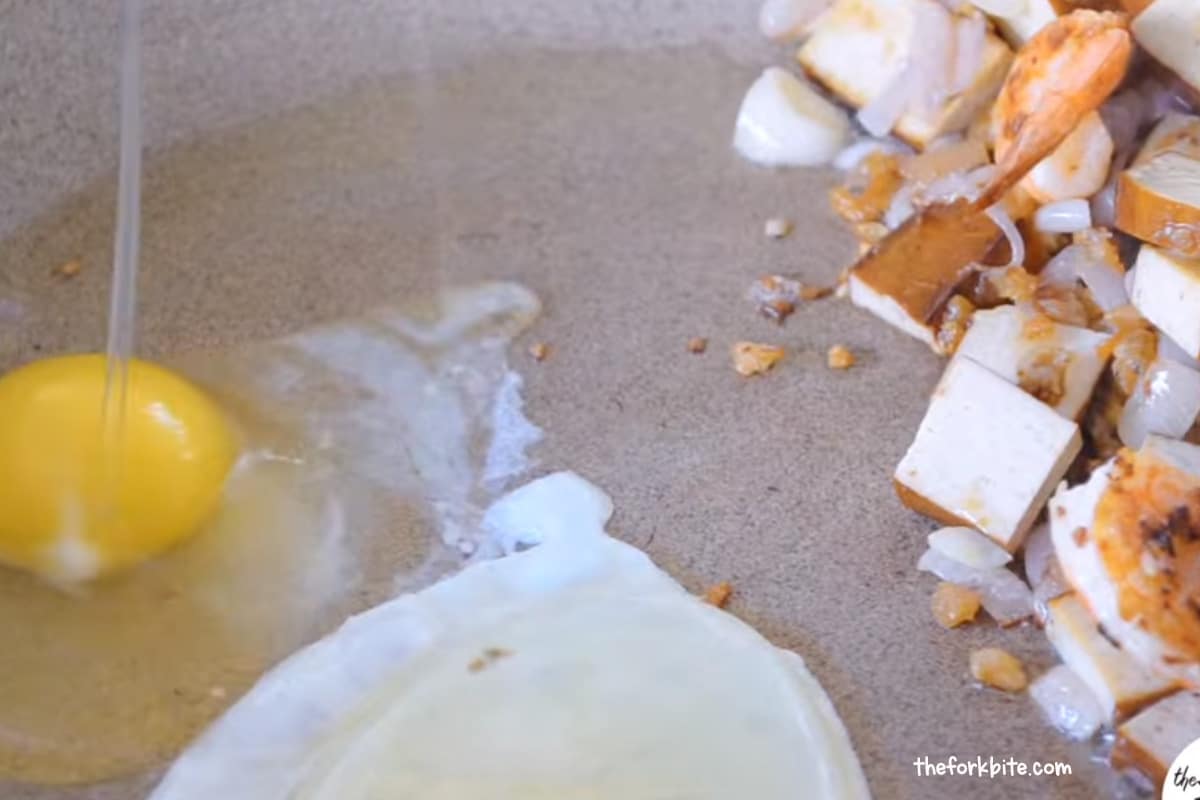
Step 6 Add noodles and pour Pad Thai sauce.
Add the noodles to the skillet and pour 1 cup of pad thai sauce. Why use 1 cup of Pad Thai sauce first? Pouring too much sauce at once may overwhelm the dish, but slowly adding it will ensure that all ingredients are moistened evenly.
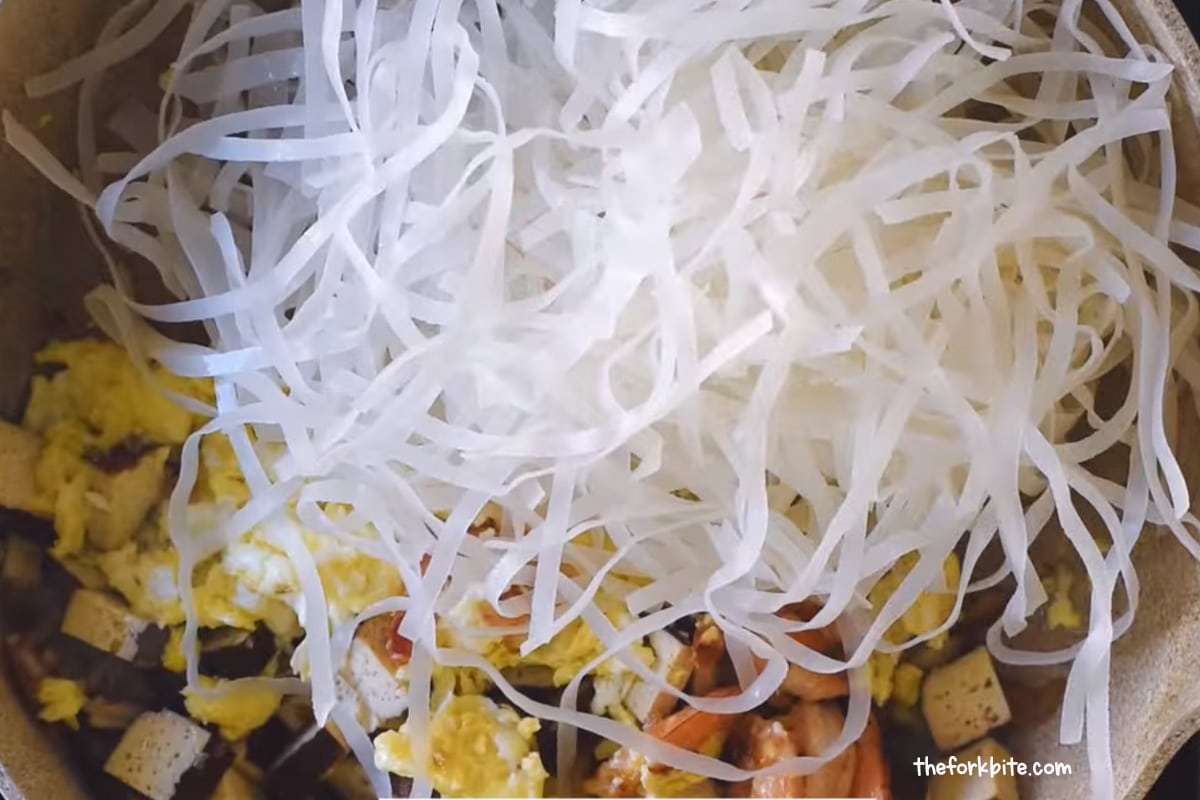
Gently toss the noodles until they absorb the sauce, adding the remaining ½ cup sauce as needed to moisten the dish. Incorporate the sauce into the noodles, tossing gently, so they are evenly coated.
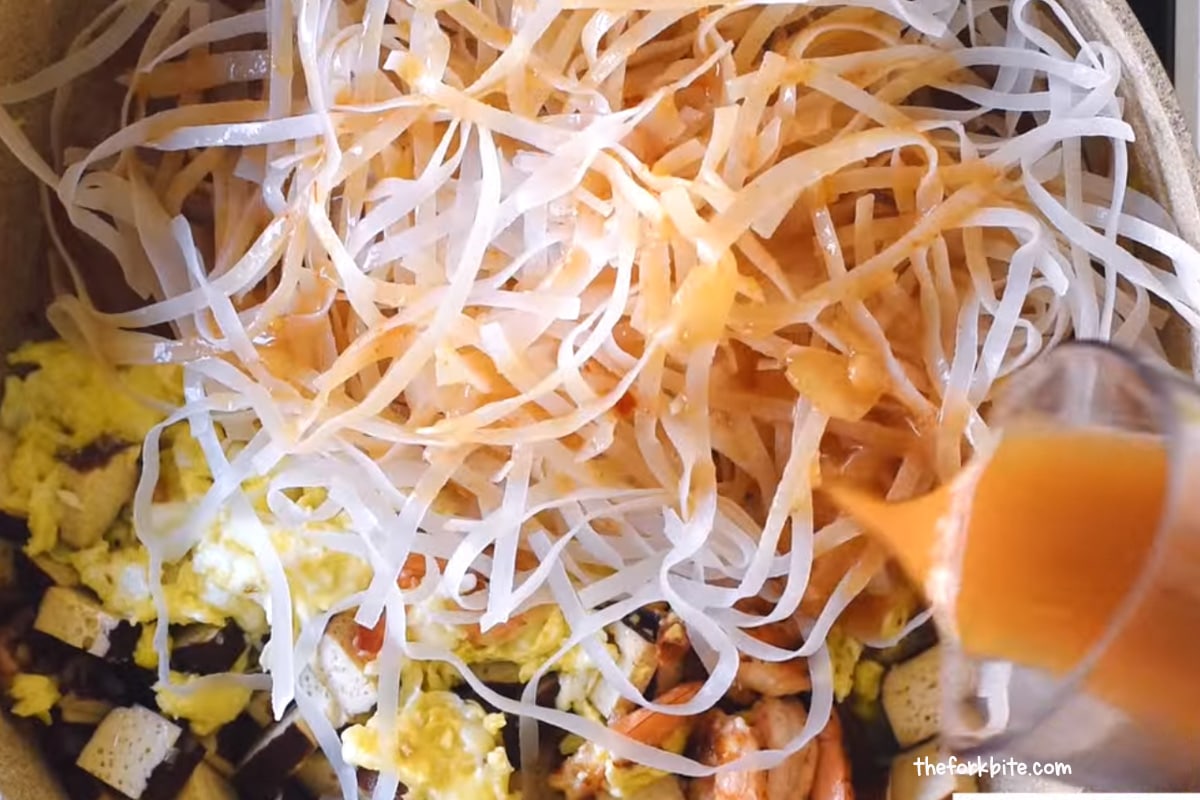
Step 7 Add some Sriracha sauce.
This is my secret ingredient for adding a bit of color and kick. It's optional, but it really brings the dish together! Give everything a quick stir, and you're almost done. Why add sriracha sauce? Not only does it add a hint of spice, but it also adds bright color and depth to the dish. Add 1 tablespoon for just a bit of spicy flavor or more if you're feeling adventurous!
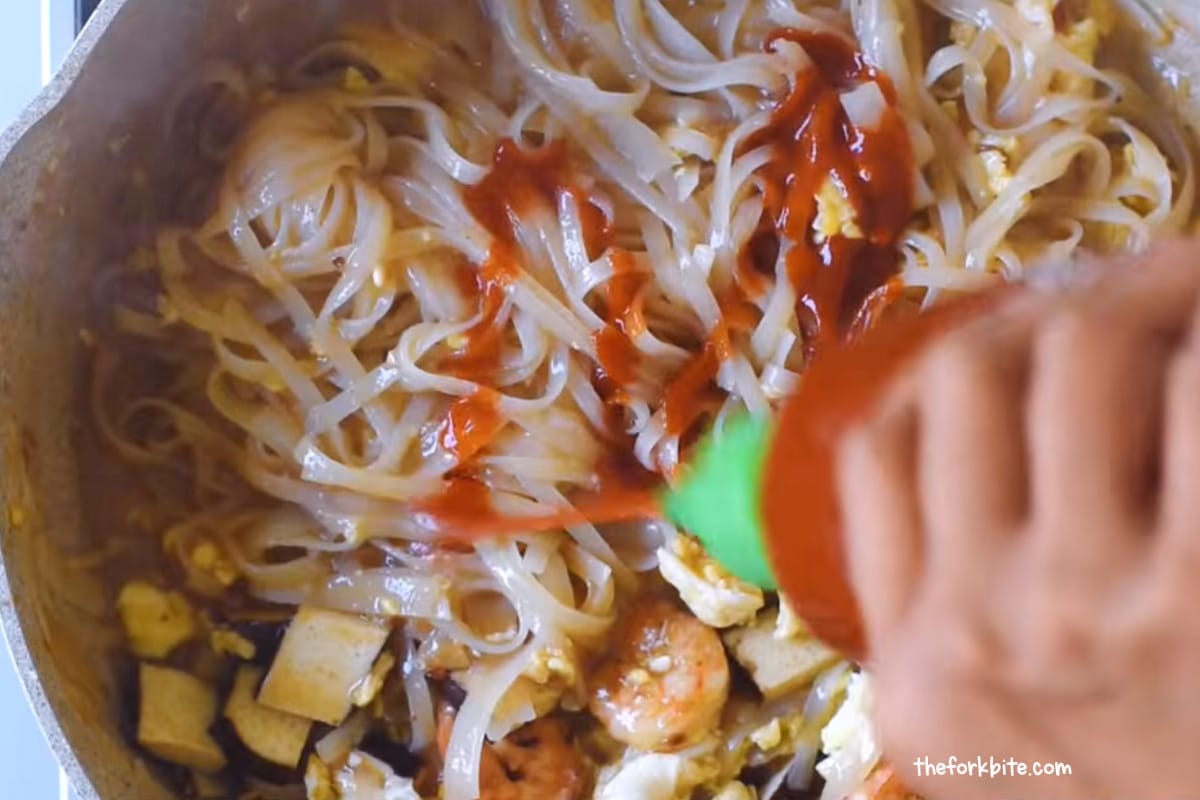
Step 8 Add the chives and sprouts, and stir quickly.
Add the chives and sprouts to the noodles and give them a quick stir to incorporate. Stirring them quickly will help the flavors and colors of all ingredients blend nicely.
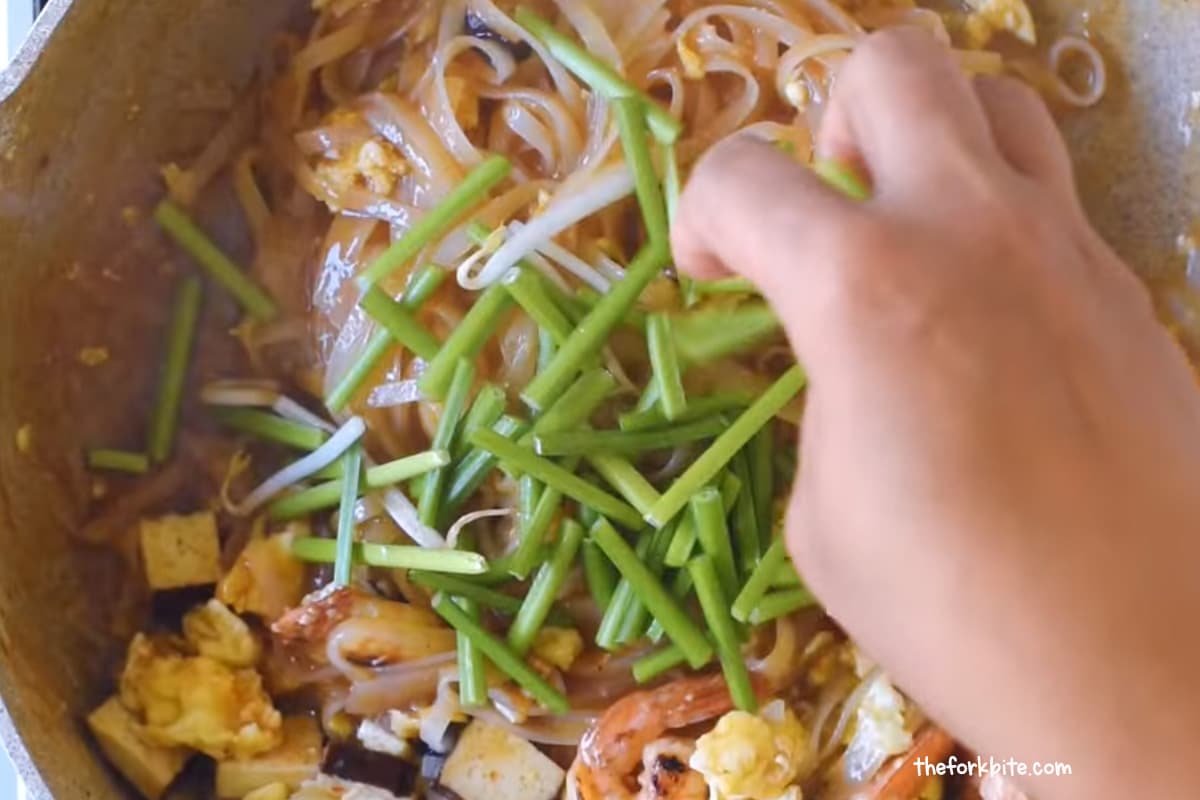
Step 9 Sprinkle crushed peanuts.
Finally, sprinkle the crushed peanuts over the noodles and give them a light toss to combine. Serve immediately and enjoy! Peanuts add texture, crunch, and nutty flavors to the dish, making it a complete meal.
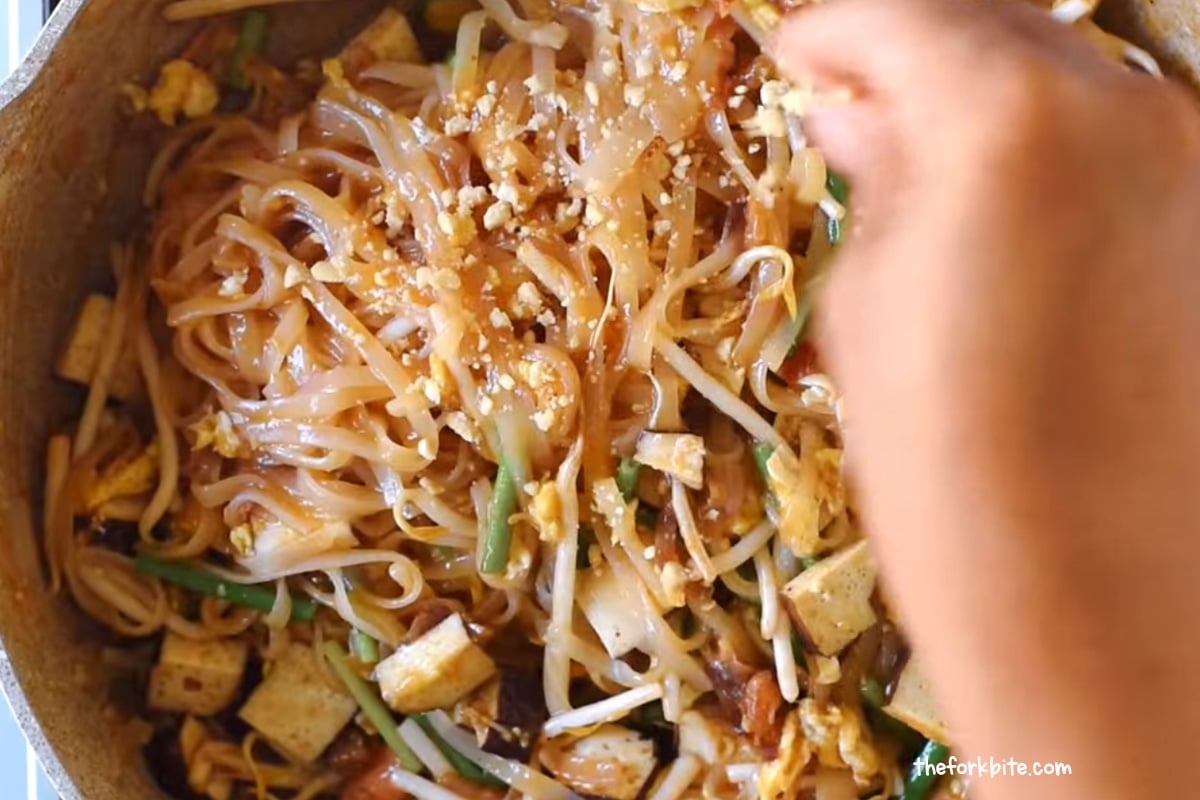
Are Pad Thai noodles gluten-free?
The answer is yes and no. Pad Thai noodles are made from rice and tapioca flour, which are naturally gluten-free. However, the traditional recipe for Pad Thai noodles also includes fish sauce, which may contain wheat and render the recipe unsuitable for those with a gluten allergy.
Fortunately, you can still enjoy Pad Thai noodles even if you are allergic to gluten. You can make the same delicious dish without worrying about allergies using vegan and gluten-free alternatives. For instance, you could use tamari or coconut aminos instead of fish sauce and skip the peanuts as a garnish.
With some simple substitutions, Pad Thai noodles are a great option for those with gluten allergies or sensitivities. So don't worry - you can still enjoy this tasty dish without compromising your health!
Read:
What are Pad Thai noodles made of?
Pad Thai noodles are made of rice flour. This means they are cooked differently than traditional noodles. They are soaked in water to soften them, making them slippery. Boiling them would make them sticky or gummy. The flour used to make these noodles is medium-sized and is about the size of Italian linguine. What makes them so versatile is that they have a mild flavor, which allows them to absorb any flavor cooked with them easily. That's why Pad Thai noodles are such a popular dish worldwide!
How long do I soak Pad Thai noodles?
You should soak your Pad Thai noodles for around 10 minutes in cold or warm water. This makes the noodles soft and slippery while not becoming too sticky or gummy. If you leave them in the water for too long, they may become overcooked. Once soaked, rinse your noodles and lightly drizzle oil over them to prevent them from sticking together.
Is Pad Thai spicy?
It is a personal preference, but generally, Pad Thai is not spicy. It usually has more of a subtle underlying flavor and can be ramped up with condiments such as ground-dried chilies. I prefer to keep it mild and enjoy the flavors without making it too spicy. However, if you like things on the spicier side, you can easily add more chili to the dish. In any case, the Thai way is to eat however you want and adjust it to your preferences- sour, spicy, salty, or sweet.
Read:
Does pad thai have peanuts?
The answer is yes and no. Pad Thai does not necessarily have to include peanuts, although it is a classic part of the dish. It does not make or break the flavor of the traditional Pad Thai recipe - you can still enjoy it without them!
I find it funny when my American friends and family ask me whether Pad Thai has peanuts. I usually answer this question with a laugh because peanut sauce is not part of Thai cuisine as I know it. In Thailand, ground-roasted peanuts are included in several dishes as an ingredient, such as satay sauce, cubed tofu sauce, and tod mun sauce.
Peanut sauce comes in three varieties in Thai cuisine:
1 Satay sauce.
This is probably the most well-known type of satay peanut dipping sauce, and it's what people usually think of when they hear "Thai peanut sauce." This satay dipping sauce is typically served with satay - marinated meat grilled on skewers - as well as some side dishes or salads. It is made with red curry paste, coconut milk, fish sauce, tamarind, sugar, and ground peanuts.
2 Thai Tofu cubes.
Fried tofu cubes are a popular dish in Thai cuisine, and it's often served with a peanut dipping sauce. This satay-style dipping sauce is made from ground peanuts, garlic, onion, sugar, tamarind paste, and fish sauce. It's richer than satay sauce but has the same depth of flavor.
3 Tod Mun.
If you love a spicy fish cake, you've got to try tod mun. This satay-style sauce is made from ground fresh chilies, vinegar, and sugar and topped with ground peanuts for texture. Cucumber is the main ingredient of the sauce, not the peanuts. It's a delicious snack you can enjoy on its own or with satay.
Note:
American fusion cuisine has been around for decades, with different flavors from all over the world being used to create new and exciting dishes. Peanut sauce is no exception, and its popularity can be attributed to manufacturers who have sourced ingredients from Thailand to help give American eaters a taste of something new.
Read:
What should Pad Thai sauce taste like?
How can you describe the taste of Pad Thai sauce? Pad Thai sauce perfectly balances sweet, salty, umami, and (tamarind) sour flavors.
1 It's sweet but not too sweet.
The sweet should be present without being overly so. In classic Pad Thai recipes, palm sugar is used for sweetness. It's not as sweet as cane sugar, so it gives a nice balance of sweetness to the overall taste. What makes it unique is the subtle use of palm sugar in the recipe. This gives a distinctive aroma to the sauce while still providing the desired sweetness. I like to share the sweetness, 50% of what should be in Pad Thai sauce.
2 Salty and umami.
Saltiness and umami are imparted by fish sauce, which has a unique taste different from regular salt. Fish sauce contributes 20% of the flavor, giving it its salty and umami flavor. It's what makes the Pad Thai sauce stand out from other sauces.
3 The sourness from tamarind.
Tamarind is what gives Pad Thai sauce that unique taste. It provides sourness and a hint of sweetness, giving it its distinct texture and smell. It is so much different from lime, which is sharp and bitter-sour. Tamarind contributes 30% of the flavor in Pad Thai sauce.
4 Spiciness (optional).
Some people like to add a bit of spiciness to their Pad Thai sauce by adding powdered chili. This is optional, but it can give it a nice kick and bring out the flavors of all the other ingredients.
Bottom line:
Every bite should be an enjoyable experience! When it comes to what a Pad Thai sauce should taste like, the truth is that there are no set rules. It can be sweet, sour, spicy, or salty - depending on how you make it and what ingredients you use. The most important thing is that all the flavors balance each other out to create an irresistible umami.
How do I make a really good Pad Thai?
- The secret is to start with high-quality ingredients - the fresher, the better. Getting garden-fresh or market-fresh vegetables, herbs, and lime juice add great flavor. And don't forget to get the noodles from an Asian supermarket!
- The trickiest part of making Pad Thai is getting the soaked noodles right. They should be flexible and solid but not completely expanded and soft. If you're unsure, under-soaking the noodles is always a safe option - you can always add more water if needed.
- Another important tip I use when making this dish is to give any added peanuts an extra roasting for a few minutes before adding them at the end. This simple step can add tons of extra flavor to your dish!
- Finally, the balance of fish sauce, tamarind, and lime are key. I never use identical amounts twice, as my palate changes over time! Everyone has different taste preferences, so no one can tell you how to balance these ingredients - experimenting and tweaking them to your taste works best.
Full Recipe
How to Make Pad Thai (A recipe)
Pin RecipeIngredients:
- 8 oz Pad Thai Rice noodles (fresh or rehydrated)
- 8 pieces Shrimp (medium-sized)
- 3 tablespoon Chives
- 3 cloves garlic (minced)
- 1 tablespoon shallots
- 2 tablespoon sweet radish
- 2 tablespoon dried shrimp (optional)
- 2 eggs
- 4 oz tofu (firm)
- 4 oz beansprouts
- 1½ cups Pad Thai sauce (check the notes for the recipe)
- 2 tablespoon roasted peanuts (crushed)
- 2 tablespoon cooking oil
Watch the Video:
Instructions:
- Heat the oil.Using a large wok or skillet, heat the oil over medium heat. Oil helps evenly distribute the heat, ensuring that all ingredients are cooked correctly and that none stick to the pan’s bottom.
- Sauté aromatics.Add the shallots and garlic, and sauté them for about 1 minute or until they are tender. Sauteing them for a short time will help release all their flavors, creating a delicious base for your meal.
- Add the sweet radish, dried shrimp (optional), and firm tofu.Add the sweet radish, dried shrimp (if using), and firm tofu. Cook these ingredients for about 1 minute or until they are heated and fragrant.
- Add cooked shrimp (or any protein).Drop the cooked shrimp or any of your favorite proteins and stir for about 1 minute. Adding cooked proteins to the dish will add more flavors and texture, making it a tasty and satisfying meal.
- Push ingredients to one side of the wok/skillet.Push all ingredients to one side of the wok/skillet, creating a clear space in the middle. Crack two eggs into the skillet and cook over medium heat until they are slightly firm but moist. They lightly scramble by moving the eggs around the skillet as they cook. Move them aside once cooked.
- Add noodles and pour pad thai sauce.Add the noodles to the skillet and pour 1 cup of pad thai sauce. Why use 1 cup of Pad Thai sauce first? Pouring too much sauce at once may overwhelm the dish, but slowly adding it will ensure that all ingredients are moistened evenly.Gently toss the noodles until they absorb the sauce, adding the remaining ½ cup sauce as needed to moisten the dish. Incorporate the sauce into the noodles, tossing gently, so they are evenly coated.
- Add some Sriracha sauce.This is my secret ingredient for adding a bit of color and kick. It's optional, but it really brings the dish together! Give everything a quick stir, and you're almost done. Why add sriracha sauce? Not only does it add a hint of spice, but it also adds bright color and depth to the dish. Add 1 tablespoon for just a bit of spicy flavor or more if you're feeling adventurous!
- Add the chives and sprouts, and stir quickly.Add the chives and sprouts to the noodles and give them a quick stir to incorporate. Stirring them quickly will help the flavors and colors of all ingredients blend nicely.
- Sprinkle crushed peanuts.Finally, sprinkle the crushed peanuts over the noodles and give them a light toss to combine. Serve immediately and enjoy! Peanuts add texture, crunch, and nutty flavors to the dish, making it a complete meal.
Notes:
How long do I soak pad thai noodles?
You should soak your Pad Thai noodles for around 10 minutes in cold or warm water. This makes the noodles soft and slippery while not becoming too sticky or gummy. They may become overcooked if you leave them in the water for too long. Once soaked, rinse your noodles and lightly drizzle oil over them to prevent them from sticking together.Making pad thai sauce ahead of time.
Making the sauce is easy, and you can store it in the refrigerator for up to 30 days. You can save time by making the dish and help create a consistent flavor between batches. At the same time, it gives you flexibility – if you’re short on time when it comes to cooking the Pad Thai, having the sauce ready saves precious moments. Ready to get started? This Pad Thai sauce is sure to become your go-to recipe! Click here for my favorite Pad Thai Sauce recipe.Nutrition Information:
Please note that all nutrition information are just estimates. Values will vary among brands, so we encourage you to calculate these on your own for most accurate results.

